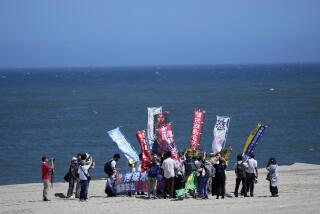Engineers try to lower danger level at crippled Japanese nuclear plant
- Share via
Engineers began injecting nitrogen into one of the reactors at the troubled Fukushima Daiichi nuclear power plant Wednesday evening as radiation levels in seawater near the plant dropped and a new report from the U.S. Nuclear Regulatory Commission suggested that the plant may face even more troubles in the future.
Officials from the United Nations, meanwhile, said that even though the situation in Japan is more serious than the U.S. faced after the Three Mile Island accident in Pennsylvania in 1979, the group does not expect severe health consequences.
Engineers began injecting inert nitrogen gas into the containment vessel of reactor No. 1 at the facility Wednesday evening in an effort to purge hydrogen and oxygen that might have accumulated from the breakdown of seawater in the reactor. Hydrogen is formed when the zirconium cladding on the fuel rods heats up and touches water, causing oxidation that releases the gas from the water.
Accumulations of hydrogen gas led to explosions in three of the reactors in the first four days after the magnitude 9 Tohoku earthquake nearly a month ago. Officials said they did not believe another explosion was imminent, but they did not want to take any chances.
They will also inject nitrogen into reactors No. 2 and No. 3.
Radiation levels in seawater near the plant, owned by Tokyo Electric Power Co., dropped dramatically even before engineers plugged a water leak at the facility on Wednesday, and authorities expect levels to continue falling now that the flow of contaminated water has diminished.
Levels of radioactive iodine had reached 7.5 million times permissible levels directly behind the plant Saturday, but by Tuesday new measurements showed that the amount of radioiodine was only 4% of that amount. That was still nearly 300,000 times the permissible limit, but levels were continuing to decline as the outflow from the plant was being diluted by the ocean.
At a point about 12.5 miles from the plant, iodine levels were down to 1.5 times the limit.
Much of the contaminated water had been entering the ocean from a leak in the tunnels under reactor No. 2. After several failed attempts to halt the leak, engineers finally succeeded Wednesday afternoon by pumping in a silicon-based polymer sometimes referred to as liquid glass. They planned to then pour concrete on top of the polymer to further seal the leak.
Engineers have also been pumping about 11,500 tons of slightly contaminated water out of holding tanks and into the ocean to make room for more highly radioactive water. But the radiation level of the water flowing into the ocean is not high enough to cause severe problems, experts said.
However, a new report from the U.S. Nuclear Regulatory Commission leaked to the New York Times suggests that the continued pumping of water into the plant may be putting a strain on the Fukushima facility that will leave it more susceptible to future earthquakes.
The report from engineers who have visited the site suggests that filling the reactor containment vessels with water that they were not designed to hold may place undue stress on the concrete vessels, leaving them susceptible to breakage if another quake strikes the facility.
The report also suggests that a fourth explosion at the site in the early days after the quake may have occurred in the spent fuel pool at reactor No. 4 and may have scattered some pieces of uranium pellets around the site between the buildings. Workers may have bulldozed dirt over the radioactive pieces in an attempt to contain the radiation, the report said.
In Vienna, Wolfgang Weiss, chairman of the United Nations Scientific Committee on the Effects of Atomic Radiation, said the Fukushima disaster was more severe than the incident at Three Mile Island three decades ago, but less of a problem than the 1986 accident at Chernobyl in Ukraine. “It is in between, in terms of environmental effects, not in terms of health impact,” he said.
Asked about its health impact, he said: “From what I have seen now, from the information I have now, I would not expect anything … serious” except for the effects on workers at the plant.
Times wire services contributed to this report.






